In the world of pest control, it’s important to understand what exactly qualifies an organism as a pest. From tiny insects to larger animals, this captivating article explores the criteria that defines a pest and why they can wreak havoc on our homes and gardens. Whether you’re curious about the nuisances that make our lives more challenging or looking for effective solutions to keep these unwanted invaders at bay, this blog is your ultimate guide. So, join us as we uncover what makes an organism a pest and learn how to protect your property from their unwelcome presence.
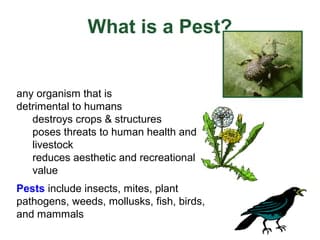
Definition of a Pest
Introduction to pests
Pests are organisms that cause harm or nuisance to humans, animals, or their surrounding environment. They can include insects, rodents, birds, weeds, and microbial organisms. Pests are known for their ability to cause damage to crops and plants, spread diseases, cause property damage, and pose health hazards. Identifying and understanding pests is crucial for effective pest control and management.
Key characteristics of pests
Pests share certain key characteristics that distinguish them from other organisms. Some of these characteristics include high reproductive potential, adaptability, and the ability to survive and thrive in various environments. Pests also possess traits that enable them to interact with humans and other organisms in ways that result in harm or nuisance. Their ability to cause significant economic damage and their resilience to control methods are additional factors that set them apart from other organisms.
Types of Pests
Insect pests
Insect pests are some of the most common and widely known pests. They include various species such as ants, mosquitoes, cockroaches, bed bugs, and termites. Insects are particularly problematic as pests due to their ability to reproduce rapidly and infest both residential and commercial areas. They can damage crops, transmit diseases, and cause discomfort and health issues for humans and animals.
Rodent pests
Rodent pests, such as rats and mice, are known for their destructive behavior and ability to spread diseases. They are highly adaptable and can be found in both urban and rural environments. Rodents can cause extensive property damage by gnawing on electrical wires, walls, and furniture. They are also notorious for contaminating food sources, posing health risks to humans and animals through their droppings and urine.
Bird pests
Bird pests, including pigeons, seagulls, and crows, can become a nuisance when their populations grow out of control. Their droppings can cause damage to buildings, vehicles, and public spaces, leading to costly repairs. Additionally, bird droppings can harbor diseases and pose health risks to humans. Birds may also prey on crops, causing significant losses in agriculture.
Weed pests
Weed pests are unwanted plants that compete with cultivated crops or native vegetation for resources. They can include invasive species such as kudzu, dandelions, and Japanese knotweed. Weeds can hinder agricultural productivity, reduce crop yield and quality, and impact the biodiversity of natural ecosystems. Controlling weed pests is essential for maintaining healthy and productive environments.
Microbial pests
Microbial pests encompass a range of microscopic organisms such as bacteria, viruses, and fungi. These pests can cause diseases in humans, animals, and plants. They can be transmitted through direct contact, contaminated water or food, or by vectors such as mosquitoes. Microbial pests pose significant health risks and can lead to outbreaks of infectious diseases if not properly controlled.
Other types of pests
In addition to the aforementioned categories, there are various other types of pests that can cause harm or nuisance. These include but are not limited to nematodes, spiders, scorpions, reptiles, and mammals such as bats or squirrels. Each of these pest types has its own unique characteristics and control methods.
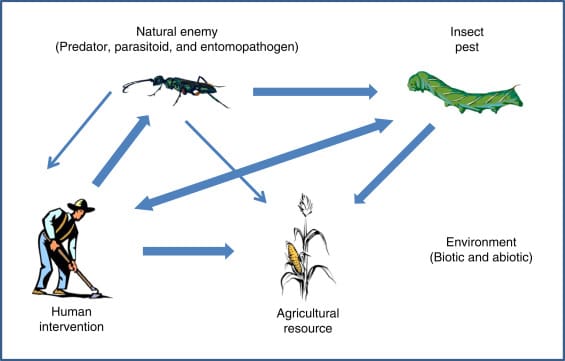
Harmful Effects of Pests
Damage to crops and plants
Pests can cause extensive damage to crops and plants, resulting in reduced yields and economic losses for farmers. Insects, rodents, and weeds are major culprits in agricultural damage. Insects may feed on plants, causing leaf damage, stunting growth, and transmitting plant viruses. Rodents can devour crops, dig up tubers, or damage storage facilities. Weeds compete with crops for nutrients, sunlight, and water, leading to decreased growth and reduced crop quality.
Spread of diseases
Pests, particularly insects and microbes, can act as vectors for various diseases. Mosquitoes, for example, are notorious for transmitting diseases such as malaria, dengue fever, and Zika virus. Ticks can transmit Lyme disease and other tick-borne infections. Rodents can carry diseases like hantavirus and leptospirosis. The spread of diseases by pests poses a significant threat to human and animal health, as well as public safety.
Property damage
Pests can cause significant damage to properties, both residential and commercial. Rodents, for example, can chew through electrical wiring, leading to potential fire hazards. Termites can destroy wooden structures, compromising the stability of buildings. Birds can create nests and leave droppings that damage roofs, windows, and outdoor surfaces. Property damage caused by pests can result in costly repairs and maintenance.
Health hazards for humans and animals
Pests pose health hazards to both humans and animals. Insect bites and stings can cause allergic reactions, pain, and itching. Pests like fleas and ticks can transmit diseases to pets and humans. Rodents carry bacteria and viruses that can cause illnesses, including salmonellosis and hantavirus. Birds’ droppings can contain pathogens that cause respiratory infections. The presence of pests in living and working environments can compromise the health and well-being of individuals.
Factors Influencing Pest Status
Environmental factors
The environment plays a crucial role in determining the status of pests. Factors such as temperature, humidity, light, and availability of food and water influence their populations and behavior. Some pests thrive in warm and humid climates, while others prefer cooler temperatures. Understanding the environmental conditions that favor pests can aid in developing effective control strategies.
Availability of resources
Pests require specific resources to survive and reproduce, including food, water, and shelter. The availability and accessibility of these resources directly impact pest populations. Abundant food sources, such as unprotected crops or easily accessible garbage, can attract and support pest infestations. Effective pest control often involves managing or disrupting these resources to make the environment less favorable for pests.
Life cycle and reproductive potential
The life cycle and reproductive potential of pests greatly influence their population growth and persistence. Pests with short life cycles and high reproductive rates can rapidly multiply and establish large populations. This makes them particularly challenging to control. Understanding the life cycles of pests can help identify vulnerable stages for targeted control measures and prevent further infestations.
Ability to adapt and survive
Pests are known for their resilience and ability to adapt to changing environments and control measures. They can develop resistance to chemical pesticides, modify their behaviors, or find new ways to access resources. This adaptability enables pests to survive and persist, making effective pest control an ongoing challenge. Keeping up with pest biology and behavior is essential for staying ahead in pest management.
Interactions with humans and other organisms
Pests often interact with humans and other organisms in ways that contribute to their pest status. For example, some pests have evolved to exploit human structures and resources. Others have co-evolved with specific hosts or prey, leading to pest problems when their population densities become unbalanced. Understanding these interactions can help develop targeted management strategies that take into account the ecological context and minimize unintended consequences.
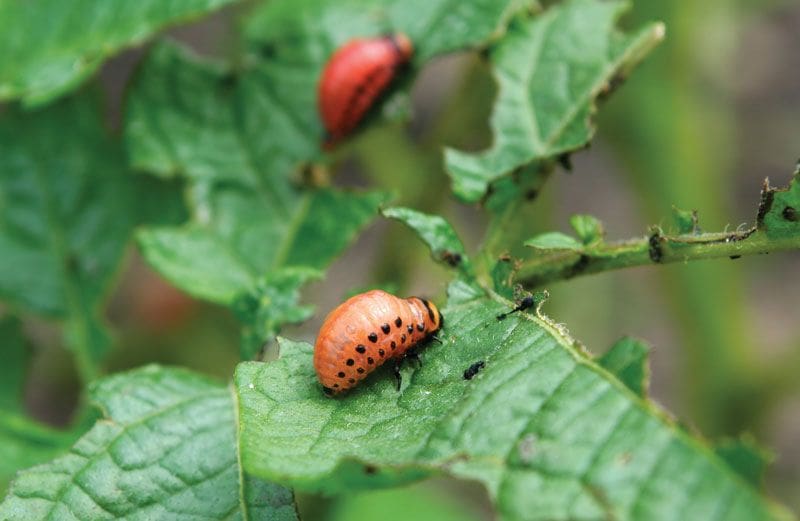
Characteristics That Determine Pest Control Strategies
Resilience to control methods
Some pests possess natural mechanisms that make them resilient to control methods. For example, insects may have developed resistance to certain pesticides through genetic mutations. This resilience can pose challenges for traditional control approaches and necessitate the development of alternative strategies. Integrated Pest Management (IPM), which combines various control methods, becomes crucial in managing pests with high resilience.
Ability to create resistance
Pests can develop resistance to control methods through genetic adaptation. This resistance can occur in response to repeated exposure to chemical pesticides or other control measures. Insects, bacteria, and weeds are known for their ability to develop resistance, rendering conventional control methods less effective over time. effective pest control strategies must take into account this potential resistance and employ multiple techniques to target different vulnerabilities.
Population dynamics
Understanding the population dynamics of pests is essential for effective control strategies. Pests can exhibit cyclic population fluctuations, with periods of high abundance followed by crashes or low numbers. Monitoring population levels helps identify the most effective time for intervention and prevent outbreaks. Integrated approaches that focus on suppressing pest populations during peak periods can maximize control effectiveness.
Degree of economic damage
The economic impact caused by pests is an important consideration in pest control strategies. Pests that cause substantial economic losses in agriculture, business, or trade often receive priority in control efforts. Balancing the costs of control with the potential benefits and economic consequences of not managing pests is crucial for efficient and sustainable pest management.
Integrated Pest Management (IPM)
Definition and principles of IPM
Integrated Pest Management (IPM) is a comprehensive approach to pest control that utilizes a combination of strategies to manage pests effectively while minimizing their impact on the environment and human health. IPM involves the integration of various pest management techniques, including cultural, biological, chemical, and physical control methods. The key principles of IPM include pest identification, monitoring, prevention, and the selective use of control measures.
Components of IPM
IPM incorporates multiple components to holistically address pest problems. These components include:
-
Pest identification and monitoring: Accurate pest identification and regular monitoring are fundamental for effective IPM. Identifying the pest species, understanding their biology, and monitoring their populations help determine appropriate control measures.
-
Prevention: Preventive measures aim to reduce the likelihood of pest infestations by eliminating or minimizing conditions that attract pests. This may involve practices such as proper sanitation, structural repairs, and the use of pest-resistant varieties in agriculture.
-
Cultural control: Cultural control methods manipulate the environment to discourage or prevent pests. Examples include crop rotation, proper irrigation, and maintenance of sanitary conditions in buildings.
-
Biological control: Biological control utilizes natural enemies, such as predators, parasites, or pathogens, to suppress pest populations. This method is typically environmentally friendly and sustainable.
-
Chemical control: Chemical control involves the targeted use of pesticides to manage pests. However, in IPM, chemical control is used as a last resort and is applied judiciously, considering the potential risks to non-target organisms and the environment.
-
Physical control: Physical control methods physically exclude, trap, or remove pests from the environment. Examples include installing barriers, using traps, or employing mechanical methods such as heat or steam.
Advantages of IPM over conventional pest control methods
IPM offers several advantages over conventional pest control methods:
-
Reduced reliance on chemical pesticides: IPM emphasizes the minimization of pesticide use, which can reduce environmental contamination and potential risks to human health. This approach promotes the use of alternative control methods, aiming for long-term sustainability.
-
Targeted control measures: By integrating multiple control strategies, IPM can effectively target pests at vulnerable stages or specific locations. This targeted approach enhances control efficiency while minimizing impacts on non-target organisms.
-
Sustainable pest management: IPM aims to achieve sustainable pest management by promoting long-term solutions rather than short-term fixes. By focusing on prevention, cultural practices, and biological control, IPM seeks to establish and maintain balanced ecosystems that can naturally regulate pest populations.
-
Cost-effective: IPM can be cost-effective in the long run by reducing the reliance on costly pesticide applications and preventing the need for extensive damage repair. By implementing preventive measures and utilizing natural control methods, the economic burden of pests can be significantly reduced.
-
Reduced environmental impact: By minimizing the use of chemical pesticides, IPM helps protect beneficial insects, wildlife, and the overall environment. This approach aligns with the principles of sustainable resource management and conservation.
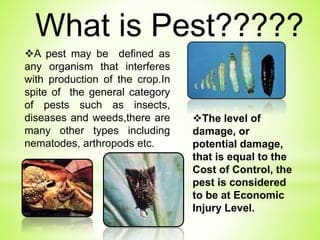
Economic Impact of Pest Infestations
Losses in agriculture
Pests pose a significant economic threat to the agriculture industry worldwide. They can cause extensive damage to crops, resulting in reduced yields, decreased quality, and increased production costs. The financial losses incurred by farmers can be substantial, leading to reduced income, increased food prices, and potential food shortages. Effective pest management is crucial for maintaining food security and economic stability in the agricultural sector.
Costs of pest control
The costs associated with pest control can be substantial, depending on the scale of infestation and the control methods employed. Chemical pesticides, for instance, can be expensive, and repeated applications may be necessary. Implementing integrated approaches, such as IPM, can help reduce the reliance on costly chemical treatments and maximize the efficiency of control measures. Investing in preventive measures and early monitoring can also significantly reduce the overall costs of pest control.
Impact on business and trade
Pest infestations can have detrimental effects on businesses and trade. Commercial sectors such as food processing, storage, and retail are vulnerable to pest problems that can damage products, contaminate facilities, and lead to consumer complaints or regulatory penalties. Infestations in commercial buildings or establishments can result in closures, loss of revenue, and damage to reputation. Pest-free environments are essential for maintaining customer satisfaction, ensuring public health and safety, and sustaining business operations.
Examples of Common Pests
Common household pests
Common household pests include insects such as ants, cockroaches, termites, bed bugs, and spiders. Rodents like rats and mice are also frequently found in residential areas. These pests can invade homes, causing damage to structures and belongings, contaminating food, and posing health risks. Effective control methods and preventive measures are essential for maintaining a pest-free living environment.
Pests in agriculture and gardens
Agricultural pests encompass a wide range of insects, weeds, and plant pathogens that damage crops and reduce agricultural productivity. Examples include aphids, caterpillars, whiteflies, nematodes, and various weed species. Garden pests, such as slugs, snails, and rabbits, can impact ornamental plants and vegetable gardens. Protecting crops and gardens from these pests requires a combination of preventive measures, cultural practices, and targeted control methods.
Pests in commercial buildings
Commercial buildings, including offices, restaurants, and hotels, are susceptible to pest infestations. Common pests found in commercial settings include rodents, flies, cockroaches, and bed bugs. These pests can pose significant health and safety risks and lead to business interruptions. Regular inspections, effective sanitation practices, and integrated pest management are necessary for preventing and controlling pests in commercial buildings.
Pests in natural ecosystems
In natural ecosystems, pests can disrupt the balance of native flora and fauna. Invasive plant species, such as kudzu or Japanese knotweed, can outcompete native plants, leading to reduced biodiversity and ecosystem degradation. Invasive animals, such as feral pigs or non-native fish, can impact ecosystems by overgrazing or outcompeting native species. Managing pests in natural ecosystems often requires the implementation of conservation measures and the control of invasive species.
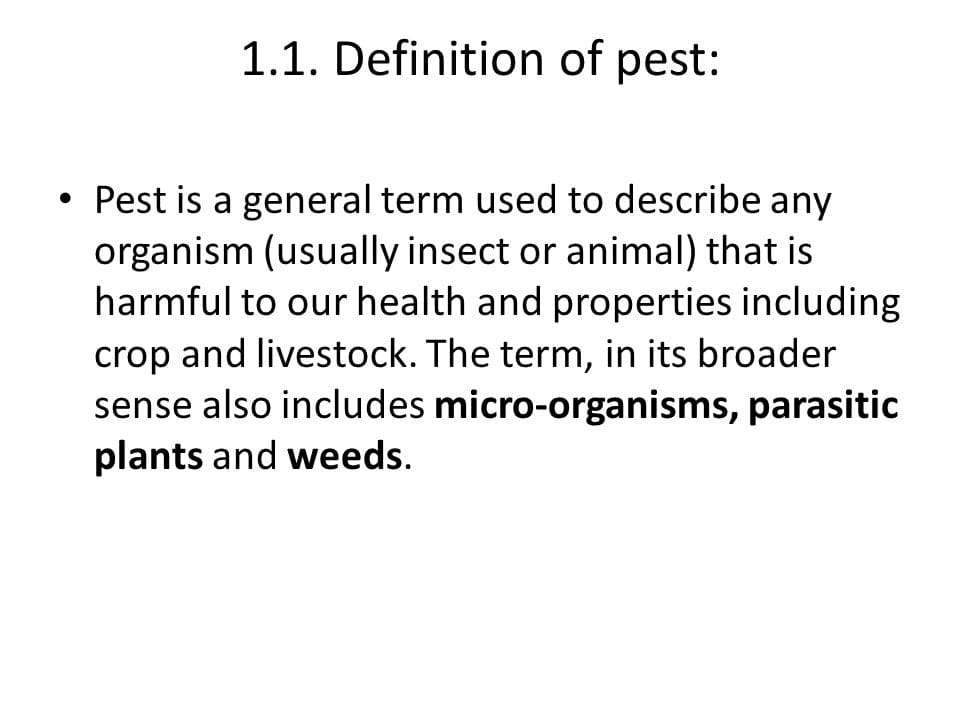
Prevention and Control of Pests
Cultural methods
Cultural methods involve modifying the environment to prevent or reduce pest infestations. These methods include practices such as proper sanitation, crop rotation, pruning, and regular maintenance. By creating unfavorable conditions for pests and promoting plant health, cultural methods can reduce the reliance on chemical control measures.
Biological control
Biological control utilizes natural enemies of pests to suppress their populations. This approach can involve the introduction of predators, parasites, or pathogens that target specific pest species. Biological control methods are often environmentally friendly and sustainable, as they rely on natural interactions between organisms. Implementing biological control strategies requires a thorough understanding of the target pests and their natural enemies.
Chemical control
Chemical control involves the use of pesticides to manage pest populations. When used judiciously and according to label instructions, chemical control can be effective in reducing infestations. However, it is essential to consider potential risks to non-target organisms and the environment. Integrated approaches, such as combining chemical control with other methods, can optimize control effectiveness and minimize adverse impacts.
Physical control
Physical control methods physically exclude, trap, or remove pests from the environment. This can involve installing barriers, using traps or nets, or employing physical techniques such as heat treatments or steam. Physical control methods can be effective for targeting specific pests or preventing their entry into a designated area.
Mechanical control
Mechanical control refers to the use of machinery or tools to physically eliminate or reduce pest populations. This can include methods such as mowing, tilling, or vacuuming. Mechanical control is commonly used for weed management, where manually removing or cutting down weeds can prevent their spread and regrowth.
Preventive measures
Preventive measures are important for minimizing the risk of pest infestations. These measures can include practices such as regular cleaning, proper waste management, sealing cracks or openings in buildings, and using pest-resistant materials or plants. Preventive measures aim to create inhospitable environments for pests, reducing the need for reactive control measures.
Conclusion
Summary of key points
Pests are organisms that cause harm or nuisance to humans, animals, and the environment. They can include insects, rodents, birds, weeds, and microbial organisms. Pests have specific characteristics that distinguish them from other organisms, such as high reproductive potential, adaptability, and the ability to interact with humans and other organisms in detrimental ways. Pest control is necessary to mitigate the harmful effects of pests, including damage to crops, spread of diseases, property damage, and health hazards.
Integrated Pest Management (IPM) provides a comprehensive approach to pest control, utilizing various strategies such as cultural, biological, chemical, and physical control methods. IPM emphasizes the importance of pest identification, monitoring, prevention, and the selective use of control measures. It offers advantages over conventional pest control methods, including reduced reliance on chemical pesticides, targeted control measures, sustainable pest management, cost-effectiveness, and reduced environmental impact.
Pest infestations have a significant economic impact, resulting in losses in agriculture, costs of pest control, and implications for businesses and trade. Implementing effective pest management strategies is crucial for minimizing economic losses and maintaining productivity in various sectors.
Common pests can be found in households, agriculture and gardens, commercial buildings, and natural ecosystems. Preventive measures and specific control methods need to be tailored to address the unique characteristics and vulnerabilities of each pest type and its respective environment.
Importance of effective pest control
Effective pest control is essential for protecting human health, preventing economic losses, maintaining food security, and preserving the environment. By understanding the characteristics and behaviors of pests, implementing integrated approaches, and prioritizing preventive measures, we can mitigate the harmful effects of pests and create healthier, more sustainable living environments.
Implications for pest management
The field of pest management continues to evolve as pests adapt, control methods improve, and environmental concerns grow. Emphasizing sustainable, integrated approaches such as IPM can lead to more effective pest control outcomes while minimizing the reliance on chemical pesticides and reducing undesirable impacts. Ongoing research, education, and collaboration among stakeholders are necessary for advancing pest management practices and achieving long-term pest control solutions.

I am Randy, the author behind PestControld.com. Drawing from decades of experience, I aim to provide valuable insights, expert advice, and practical recommendations to help you make informed decisions when assessing viable pest control solutions.